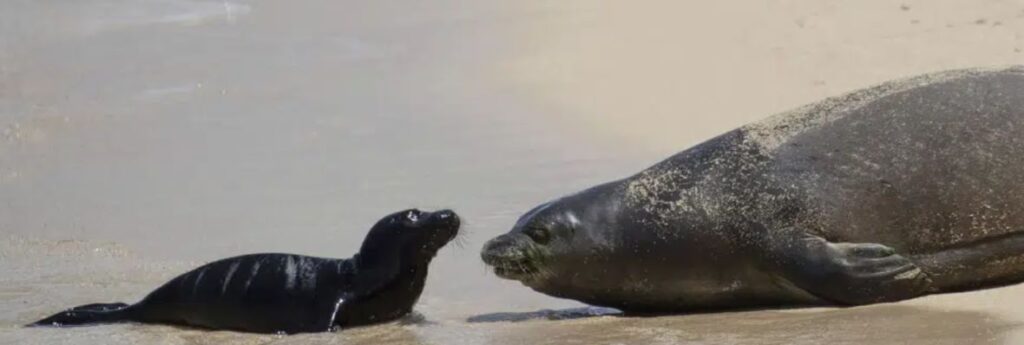The birth of an endangered seal at one of Hawaii’s most popular tourism hubs is highlighting the tension between protecting the islands’ fragile ecosystems and maintaining access to the pristine white-sand beaches that attract millions of visitors each year.
Hawaii officials fenced off a large stretch of a popular Waikiki neighbourhood last week to protect the Hawaiian monk seal, named Kaiwi, and her days-old pup (banner photo).
Kaimana Beach is next to a mid-sized hotel and is a favourite swimming and sunbathing spot for locals and visitors. Starting six years ago, monk seals have occasionally given birth there, setting the stage for conflict between seal mothers and beachgoers.
Authorities are taking extra care this spring after a California tourist got too close to a mother-pup pair last year, and was pulled underwater by the mother, leaving cuts on the 60-year-old visitor’s face, arms and back.
Officials have cordoned off part of Kaimana Beach when pups were born before, but the protected area this spring is much larger.
When the seals are in the water, law enforcement officers from the state Department of Land and Natural Resources will ride personal watercraft to keep people outside a 45-m. protective area around the animals.
Kaiwi had one other pup at Kaimana two years ago. She gave birth again on April 14, and scientists expect her and her pup to stay together at Kaimana for about five to seven weeks while the baby nurses.
Monk seal mothers are protective of their pups during this period. Authorities say it would be best if swimmers frequented one of Oahu’s many other shorelines until the pup weans.
It’s “better to select another beach where you don’t have to worry about a seal unexpectedly coming up on you,” said Diana Kramer, regional marine wildlife response coordinator for the National Oceanic and Atmospheric Administration.
Keeping people and seals apart will help the pup as it starts exploring the ocean and learns how to swim so it can eventually forage for food. The newborn is very impressionable at this age, and biologists are worried that becoming overly accustomed to people will affect its ability to thrive in the wild.
In previous years, NOAA officials relocated the new seals after they weaned and their mother left. Biologists and veterinarians took them to remote spots on Oahu where they could grow up with other wild monk seals and without much human interaction.
Fewer than 1,600 Hawaiian monk seals remain in the wild and it is a felony to disturb them.
Kaimana Beach has been the site of four Hawaiian monk seal births since 2017, starting with a mother named Rocky; she became the first seal to give birth in Waikiki since NOAA began keeping track in the 1970s.
Sami Broerman, who was reading a book in a beach chair fronting the green plastic fence, said she had decided to stay at a nearby hotel during her one-week vacation specifically because it had great beach access. She called the fence “a bummer” but also noted she was “still in Hawaii.”
“I respect it. I think it’s great. It’s just – a little more beach view would be nice,” said Broerman, who was visiting from Colorado.
Susan Chace also expressed understanding, even though she’s sad the beach will be closed off for more than half of her one-month stay.
“If it wasn’t for them, the beach won’t be as beautiful,” said Chace, who is from Platteville, Wisconsin.
Waikiki is home to a kilometres-long stretch of hotels and white-sand beaches. It is the largest hub for tourism in Hawaii, which draws 10 million travellers annually. Oahu attracted 4.9 million visitors last year.

